| Srl | Item |
| 1 |
ID:
108181


|
|
|
| 2 |
ID:
146545
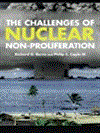

|
|
|
|
|
| Publication |
Lanham, Rowman and Littlefield, 2015.
|
| Description |
xvi, 238p.pbk
|
| Series |
Weapons of Mass Destruction Series; 2
|
| Standard Number |
9781442223752
|
|
|
|
|
|
|
|
|
|
|
|
Copies: C:1/I:0,R:0,Q:0
Circulation
| Accession# | Call# | Current Location | Status | Policy | Location |
| 058759 | 327.1747/BUR 058759 | Main | On Shelf | General | |
|
|
|
|
| 3 |
ID:
094500
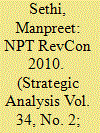

|
|
|
|
|
| Publication |
2010.
|
| Summary/Abstract |
Amongst the challenges that bedevil the Non-Proliferation Treaty (NPT) today, the NPT Review Conference (RevCon) 2010 will have to particularly handle two issues: one, right of non-nuclear weapon states (NNWS) under Article IV over the entire nuclear fuel cycle; two, identification by nuclear weapon states (NWS) of credible moves under Article VI for realising disarmament. In addressing the two interlinked issues, the RevCon has an opportunity to refocus the 40-year-old treaty into an effective instrument of non-proliferation and disarmament-its original twin objectives. The article also recommends the role that India can play in helping the NPT overcome its challenges. As a non-member, India has no direct stake in the treaty, but non-proliferation is an objective that furthers India's national security.
|
|
|
|
|
|
|
|
|
|
|
|
|
|
|
|
| 4 |
ID:
118127
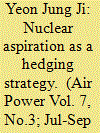

|
|
|
| 5 |
ID:
117448
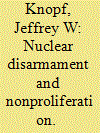

|
|
|
|
|
| Publication |
2012.
|
| Summary/Abstract |
Does the extent or lack of progress toward nuclear disarmament affect the health of the nuclear nonproliferation regime? Commentators have long asserted both positive and negative responses to this question as if the answer were self-evident. Given that opposite positions have been advanced with equal conviction, a more systematic analysis is required. This analysis begins by attempting to identify all of the potential arguments that can be made both for and against the hypothesis of a disarmament-nonproliferation linkage. The arguments are grouped in terms of five broader sets of explanatory factors: security, institutions, norms, domestic politics, and psychology. This approach clarifies the various causal microfoundations that could underpin different arguments in the debate as well as the types of empirical tests that would be most relevant for evaluating the "linkage hypothesis." Comparative assessment of the arguments on both sides suggests that signs of commitment to nuclear disarmament by the nuclear weapon states will tend to enhance support for nonproliferation. Because of the multitude of other factors that affect state decisionmaking, however, progress on disarmament will not by itself address all of the challenges to making the nonproliferation regime effective.
|
|
|
|
|
|
|
|
|
|
|
|
|
|
|
|
| 6 |
ID:
131075
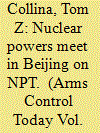

|
|
|
| 7 |
ID:
093558


|
|
|
|
|
| Publication |
2010.
|
| Summary/Abstract |
The nuclear weapon states (NWS) have different perspectives on the desirability and feasibility of a world without nuclear weapons. A review of each of the current nuclear doctrines, postures, and disarmament policies of the five NWS shows that there is a clear divide between them, with some showing relatively determined leadership (the United States and the United Kingdom) and others expressing skepticism, if not complete disinterest (France, Russia, and China). Nevertheless, the prospects for progress on disarmament by the NWS at the 2010 Review Conference of the Treaty on the Non-Proliferation of Nuclear Weapons remain reasonably good. Yet complete success will require much time as well as sustained and applied efforts from the NWS, first and foremost to improve their performance as international security guarantors.
|
|
|
|
|
|
|
|
|
|
|
|
|
|
|
|
| 8 |
ID:
115737
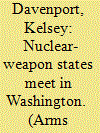

|
|
|
| 9 |
ID:
185995
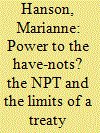

|
|
|
|
|
| Summary/Abstract |
The nuclear Non-Proliferation Treaty (NPT), its evolution over the past five decades, and the dissatisfaction of the non-nuclear states within it, can be analyzed by focusing on different understandings of power. Within the various concepts of power are claims which distinguish between what is known broadly as “power-over” and a more subtle form of influence, “power-to.” This article explores the history of the NPT, showing how the nuclear weapon states have shaped and limited this institution by practices which fall within the relational emphasis of “power-over.” Recently, however, non-nuclear states have adopted a “power-to” approach. Frustrated by their inability to bring about substantive change within the limits of the NPT, these states have realized and applied their agency and collective “power-to” in order to create an alternative approach to the problem of nuclear weapons in the context of the Treaty on the Prohibition of Nuclear Weapons (TPNW).
|
|
|
|
|
|
|
|
|
|
|
|
|
|
|
|
| 10 |
ID:
094563
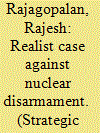

|
|
|
|
|
| Publication |
2010.
|
| Summary/Abstract |
Nuclear disarmament is once again fashionable. If rhetoric was sufficient, nuclear disarmament should be easily achievable. But what the rhetoric hides is not only the difficulty of achieving nuclear disarmament, but also the instrumental manner in which that rhetoric is being deployed. At the height of the Cold War, the two superpowers traded a number of detailed proposals for controlling the atom. Much later, Paul Nitze, one of the key participants on the US side, revealed that most of these proposals were deliberately designed to be rejected and were proposed as public relations gimmicks rather than as serious diplomatic positions.1 One can say the same about the current overheated buzz about nuclear disarmament: as in the 1950s, this is designed to serve specific policy goals that are related to nuclear non-proliferation and other nuclear arms control measures rather than nuclear disarmament.
|
|
|
|
|
|
|
|
|
|
|
|
|
|
|
|
| 11 |
ID:
150083
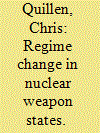

|
|
|
|
|
| Summary/Abstract |
The threat of losing control of nuclear weapons during political crises is not sufficiently prepared for by either individual nuclear powers or the international community. The relative success of securing the Soviet nuclear arsenal after the collapse of the USSR has lulled the world into a false sense of security, but the threat is real and may be increasing. Drawing upon historical case studies in which the government of a nuclear weapon state failed, the author recommends policy options for future scenarios in the hope of preventing potential nuclear disasters in newly proliferating states such as North Korea and Iran.
|
|
|
|
|
|
|
|
|
|
|
|
|
|
|
|
| 12 |
ID:
093564
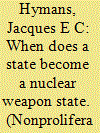

|
|
|
|
|
| Publication |
2010.
|
| Summary/Abstract |
When does a state become a "nuclear weapon state"? How we choose to answer this question has significant implications for proliferation assessment, analysis, and policy. Traditionally, the standard demarcation line has been a state's first nuclear test, but in recent years analysts have increasingly focused instead on the accumulation of a significant quantity (SQ) of fissile material. The article argues that although the test/no-test indicator clearly has problems, its replacement by the SQ/no-SQ indicator would be highly counterproductive. The article instead proposes supplementing the traditional test/no-test indicator with a theory-driven approach that focuses on the incentives and disincentives to test.
|
|
|
|
|
|
|
|
|
|
|
|
|
|
|
|